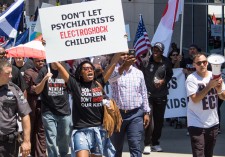Mental Health Industry Watchdog Launches Petition to FDA Commissioner to Ban Electroshock Device

Los Angeles, California, May 4, 2017 (Newswire.com) - Mental health industry watchdog Citizens Commission on Human Rights (CCHR) International has launched a petition during Mental Health Month to ban the use of electroshock (also known as electroconvulsive therapy or ECT) devices being used on children, the elderly and vulnerable patients. The petition is directed to Dr. Stephen Ostroff, M.D., Acting Commissioner of the Food and Drug Administration (FDA), as the agency that regulates the ECT device.
About 100,000 Americans are estimated to be administered electroshock each year, including children aged five or younger, the elderly and pregnant women. CCHR wants to see safer methods used to help those with behavioral or emotional problems.
CCHR says that in the interests of informed consent rights, better protections are needed when treatments have potential serious adverse effects.
CCHR International
At a 2011 FDA hearing and in a December 2015 FDA Draft Guidance on ECT devices, the agency said that ECT may cause: prolonged or delayed onset seizures, cardiovascular complications (including heart attacks), breathing complications, confusion, permanent memory loss, brain damage and death.[1] In 2014, Texas, the only state to issue an annual ECT report, revealed six deaths shortly after ECT administration.[2]
CCHR recently filed Freedom of Information Act requests (FOIAs) to all U.S. states to obtain statistics on how many children and others are being electroshocked in the country. It established that in one state alone, Utah, electroshock was administered 50 times to children and adolescents up to the age of 17 in recent years—including 15 times to those five years old or younger. Tricare military insurance also reported seven children aged 0 to 17 were given ECT in 2016.[3]
The statistics collected to date prompted the petition after CCHR found that most people thought electroshock was no longer used and were unaware that only four U.S. states—Colorado, California, Tennessee and Texas—have banned its use in children and adolescents. However, the World Health Organization's Resource Book on Mental Health, Human Rights and Legislation, recommended in 2005: "There are no indications for the use of ECT on minors, and hence this should be prohibited through legislation."[4]
A considerable number of people receiving ECT are patients that are involuntarily admitted to psychiatric facilities, where their right to consent to or refuse treatment can be overridden—a practice that in 2013, Juan E. Méndez, the UN Special Rapporteur on Torture and Other Cruel, Inhuman or Degrading Treatment or Punishment, said could constitute torture in healthcare settings. Mr. Méndez called for an "absolute ban on all forced and non-consensual medical interventions against persons with disabilities," including electroshock.[5]
Electroconvulsive therapy has a controversial history in that it was developed in 1938 by an Italian psychiatrist who adapted electric shock techniques to stun pigs in a Rome slaughterhouse and went on to create ECT for use in humans.[6] Today, up to 460 volts of electricity are used to produce a grand mal seizure in patients, which both experts and the FDA report could cause brain damage.[7]
CCHR says that in the interests of informed consent rights, better protections are needed when treatments have potential serious adverse effects.
CCHR encourages anyone who has been harmed by ECT, or whose family member has been harmed, to report this to CCHR by filling out this form (all information kept in strictest confidence).
CCHR was established in 1969 by the Church of Scientology and the late professor of psychiatry, Dr. Thomas Szasz. As a mental health industry watchdog, its mission is to inform and mobilize the public against violations of human rights and civil liberties committed in the mental health system. It has been instrumental in obtaining more than 175 laws with protections, including informed consent rights for mental health patients, and was instrumental in the first ban of ECT use in children in California in 1976. The most recent legislative action against ECT was in Western Australia, where it was banned in 2014 for those aged 14 and younger.[8] For more about CCHR, click here.
Contact: Amber Rauscher, media@cchr.org or (323) 467-4242.
References:
[1] "Electroconvulsive Therapy (ECT) Devices for Class II Intended Uses," Draft Guidance for Industry, Clinicians and Food and Drug Administration Staff, 29 Dec. 2015, http://www.fda.gov/downloads/MedicalDevices/…/UCM478942.pdf; Neurological Devices Panel, Center for Devices and Radiological Health Medical Devices Advisory Committee, Food and Drug Administration, pp 148-149, 27 Jan. 2011, http://www.fda.gov/downloads/AdvisoryCommittees/CommitteesMeetingMaterials/MedicalDevicesAdvisoryCommittee/neurologicalDevicesPanel/UCM247594.pdf.%20Accessed%20December%203.
[2] Jonathon Emord & Associates, Citizens Petition filed with the FDA Commissioner, 14 Aug. 2016; citing Texas Department of State Health Services. Electroconvulsive Therapy (ECT) Reports. FY 2014 ECT Annual Report, page 1. http://www.dshs.texas.gov/mhsa/bhmd/ect/.
[3] "Evidence for Use of Electroshock on Veterans," 24 July 2015, https://talkwithtenney.wordpress.com/2015/07/24/evidence-for-use-of-electroshock-on-veterans/.
[4] Benedetto Saraceno, MD, "WHO Resource Book on Mental Health, Human Rights and Legislation Who 2005," p. 64.
[5] A/HRC/22/53, "Report of the Special Rapporteur on torture and other cruel, inhuman or degrading treatment or punishment, Juan E. Méndez," United Nations, General Assembly, Human Rights Council, Twenty-second Session, Agenda Item 3, 1 Feb. 2013, p. 21, http://www.ohchr.org/Documents/HRBodies/HRCouncil/RegularSession/Session22/A.HRC.22.53_English.pdf.
[6] http://www.sciencemuseum.org.uk/broughttolife/techniques/ect; "Origins of ECT," Convulsive Therapy, Vol. 4, No. 1, 1998, p. 7, http:/www.academia.edu/10921818/The_Origins_of_Electroconvulsive_Therapy_ECT.
[7] Op. cit., Jonathon Emord & Associates, Citizens Petition; Op Cit., Neurological Devices Panel, Center for Devices and Radiological Health Medical Devices Advisory Committee, Food and Drug Administration, pp 148-149.
[8] "Electroshock therapy on under-14s banned in WA after law passes Parliament," ABC News, 17 Oct. 2014, http://www.abc.net.au/news/2014-10-17/mental-health-bill-passes-wa-parliament/5822874.
Source: Citizens Commission on Human Rights (CCHR) International
